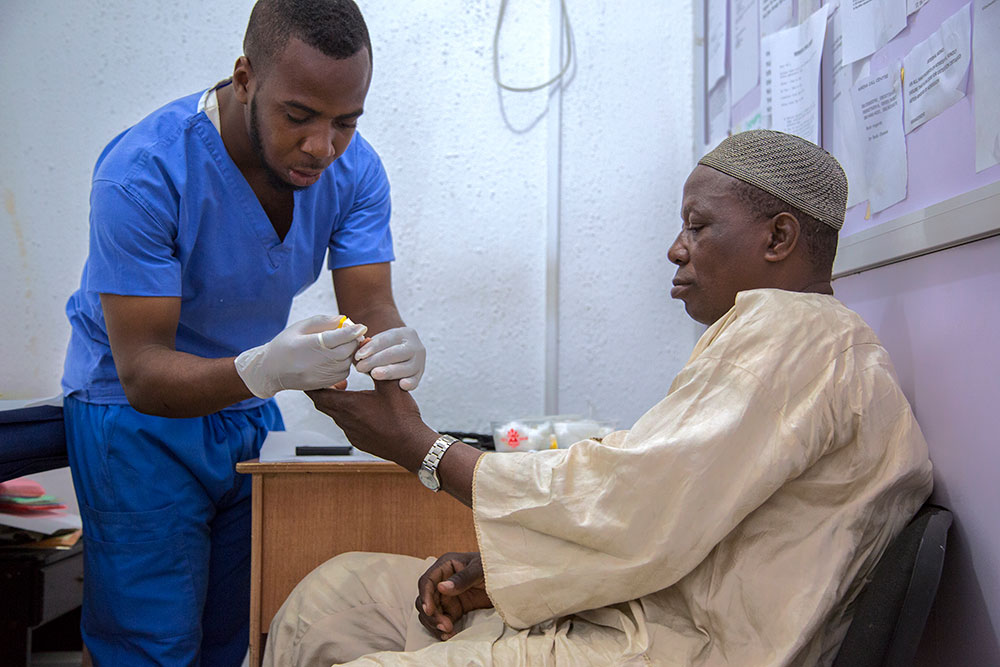Management of NCDs
Managing noncommunicable diseases (NCDs) is just as important as prevention. It is therefore vital to invest in proper management of NCDs, which encompasses detection, screening, treatment of the diseases, and palliative care for those in need.
Unfortunately, a large number of premature NCD-related deaths occur in low- and middle-income countries where access to healthcare is limited. Implementing effective NCD interventions through primary healthcare can improve early detection and timely treatment. Early intervention also proves to be a cost-effective investment as it can lower the need for more costly treatment later. However, areas with limited health insurance coverage may struggle to provide universal access to necessary NCD interventions.
To combat NCDs and decrease the number of preventable deaths, it is crucial to develop and implement universal health coverage. Implementing NCD management measures is crucial to reach global targets such as reducing premature NCD-related deaths by 25% by 2025 and one third by 2030 as outlined in the Sustainable Development Goals.
Managing NCDs

Every year, more than 2.8 million people in the Eastern Mediterranean Region die from the main NCDs alone. Cardiovascular diseases account for most NCD deaths, followed by cancers, chronic respiratory diseases, and diabetes (including kidney disease deaths caused by diabetes). The rates of mental health disorders, specifically depressive illness and anxiety disorders are also high in countries of the Region. Collectively, the main NCDs are responsible for 66% of all deaths in the Region. It is therefore vital to invest in proper management of NCDs.
Managing cardiovascular diseases
Cardiovascular diseases (CVDs) are responsible for the majority of NCD-related deaths in the Region each year. CVDs are a group of disorders of the heart and blood vessels and include conditions such as coronary heart disease, cerebrovascular disease and rheumatic heart disease. The majority of CVD deaths are caused by heart attacks and strokes, with one third happening prematurely in individuals under 70.
The main contributors to heart disease and stroke are unhealthy diet, physical inactivity, tobacco use and harmful use of alcohol. These behaviours can lead to elevated blood pressure, elevated blood glucose, elevated blood lipids and overweight and obesity. These intermediate risk factors can be detected in primary care facilities and signal a higher risk of heart problems, such as heart attacks, strokes and heart failure.
Preventing CVDs can be achieved by quitting tobacco use, reducing salt intake, eating more fruits and vegetables, engaging in physical activity and avoiding harmful use alcohol. Health policies that make healthy choices affordable and accessible are crucial for promoting healthy behaviours. Beyond prevention, early identification of those at high risk of CVDs and providing appropriate treatment can prevent premature deaths. Access to NCD medications and basic healthcare technologies in all primary healthcare facilities is vital for ensuring patients receive treatment and counselling.
WHO works with governments to prevent, manage and monitor CVDs by creating strategies to decrease the occurrence, severity and mortality of these diseases. These strategies involve reducing risk factors, establishing standards of care, increasing healthcare system capacity and monitoring disease patterns and trends to guide national and global action.
Managing cancer
Cancer is more likely to be successfully treated when detected early, leading to increased survival rates, less complications, and lower treatment costs. There are two approaches to early detection.
- Early diagnosis identifies symptomatic cancer cases as soon as possible.
- Screening identifies individuals with signs of specific cancer or pre-cancer, even if they have no symptoms, and quickly refers them for diagnosis and treatment.
Treatment options may include surgery, medication, radiotherapy, or a combination, and are determined by a team of cancer experts based on factors such as tumour type, cancer stage, and patient preferences. Consideration of the health system's capacity is also important.
Palliative care, which prioritizes quality of life for patients and their families, is a crucial aspect of cancer care. Survivorship care involves monitoring for cancer recurrence and new cancers, managing long-term effects of cancer and treatment, and addressing cancer survivors' needs.
Managing chronic respiratory diseases
Asthma and chronic obstructive pulmonary disease (COPD) are chronic conditions that cannot be cured, but their symptoms can be managed with proper treatment. During episodes of breathlessness caused by airway narrowing, inhaled medicines known as bronchodilators can help open the airways and relieve symptoms. Untreated severe episodes can result in death.
Proper management of asthma with inhaled corticosteroid medication can control the progression of the disease and lower the risk of deaths. People with persistent symptoms require long-term treatment, and should avoid triggers such as smoke, fumes, dust, grass and tree pollen, animal fur and feathers.
COPD is diagnosed using a spirometry test, which measures a person's ability to exhale air from their lungs. Symptoms can be treated with medical and physical treatments, but the most effective method for people who smoke tobacco is to quit smoking. This can slow down the progression of the disease and reduce COPD-related deaths. In some cases, inhaled corticosteroid medicines may also benefit people with COPD.
Managing diabetes
Currently, there is no way to prevent type 1 diabetes. However, there are effective measures that can be taken to prevent type 2 diabetes and the related complications and early deaths that can result from all types of diabetes. These measures include implementing policies and practices that promote healthy lifestyles across populations and in specific settings, such as schools, homes and workplaces. These practices include regular exercise, a healthy diet, avoiding smoking, and controlling blood pressure and lipids, regardless of whether an individual has diabetes.
A timely diagnosis is crucial for managing diabetes effectively. The earlier a person is diagnosed with diabetes, the better their health outcomes are likely to be. Access to basic diagnostic tests, such as blood glucose testing, should be easily available in primary healthcare facilities. Patients may also need periodic specialist assessments or treatments for complications.
There are a number of cost-effective interventions that can improve patient outcomes, regardless of the type of diabetes they have. These interventions include controlling blood glucose through a combination of diet, physical activity and medication if necessary, controlling blood pressure and lipids to reduce cardiovascular risk and other complications, and regular screening for eye, kidney, and foot damage to facilitate early treatment.
WHO Package of essential NCD (PEN) interventions for primary health care

NCDs are long-lasting illnesses caused by a combination of genetic, physiological, environmental and behavioural factors. In low-resource settings, an integrated approach is crucial to make the best use of limited resources. The WHO Package of Essential NCD Interventions aims to enhance the accessibility of appropriate services for people living with NCDs in primary care settings.
WHO Package of essential NCD (PEN) interventions for primary health care
Global Hearts Initiative
The Global Hearts Initiative was established by WHO and the United States Centers for Disease Control and Prevention (US CDC) in 2016 to aid governments in improving the prevention and control of cardiovascular diseases (CVDs). It includes five technical packages that offer a range of high-impact, evidence-based interventions to have a significant effect on global heart health when used together.
On the prevention side: the MPOWER package focuses on tobacco control, aligned with the WHO Framework Convention on Tobacco Control; the ACTIVE package focuses on increasing physical activity; the SHAKE package focuses on reducing salt consumption; and the REPLACE package focuses on eliminating trans fats from the food supply. On the management side, the HEARTS technical package aims to enhance the management of CVDs in primary health care.
Global Hearts Initiative brochure
Global Hearts Initiative Infographic
HEARTS technical package and online course

The HEARTS technical package aims to improve cardiovascular health in countries and comprises six modules and an implementation guide. It helps ministries of health to enhance the management of CVDs in primary health care settings and is comprised of practical, step-by-step instructions, supported by a comprehensive technical document outlining the rationale and framework for this integrated approach to the management of noncommunicable diseases (NCDs).
CVD is the leading cause of death globally, with over 75% of heart disease and stroke-related deaths occurring in low- and middle-income countries. The HEARTS modules are intended for use by policy-makers and programme managers within ministries of health and in resource-limited settings to improve primary care delivery for CVDs.
The HEARTS technical package is part of the wider Global Hearts Initiative, which also includes two other packages for preventing CVDs. The modules were developed under the leadership of WHO and the US Centers for Disease Control and Prevention through the Global Hearts Initiative. The modules include information on a total risk approach for assessing and managing CVDs, including country-specific risk charts.
HEARTS technical package for cardiovascular disease management in primary health care
Online training on the HEARTS technical package
Regional framework for action on rheumatic fever and rheumatic heart disease

Globally, rheumatic heart disease (RHD) is the primary reason for preventable heart-related deaths among individuals under 25 years old. RHD is caused by the Streptococcus A bacterium, which is commonly found in childhood infections such as strep throat. When this infection goes untreated, it can trigger an autoimmune response in some children leading to acute rheumatic fever (RF). RF affects joints, skin, nerves and the heart, and although patients can recover, the damage caused to the heart valves is permanent and can result in heart failure, stroke, heart rhythm issues, and even maternal death during pregnancy. To prevent further damage, regular antibiotics are necessary for children diagnosed with RF to prevent additional infections and episodes of the disease.
The majority of RF/RHD cases occur in developing countries and are linked to poverty and overcrowded living conditions. The WHO Eastern Mediterranean Region has a significant ongoing public health challenge from RF/RHD. The World Health Assembly, WHO’s governing body, has taken action by passing resolution WHA71.14 in May 2018 to address the global impact of the disease. This regional framework for action on RF/RHD aims to guide implementation of this resolution in the Region. The framework was endorsed by Member States at the 66th session of the WHO Regional Committee for the Eastern Mediterranean in October 2019.
Video: Rheumatic heart disease is preventable so be a catalyst for change
Palliative care

Palliative care is an essential component of a comprehensive and patient-centered healthcare system. The alleviation of severe suffering, whether it be physical, psychological, social or spiritual is a universal moral obligation. This means that palliative care may be required for various conditions such as cardiovascular diseases, cancer, major organ failure, drug-resistant tuberculosis, severe burns, end-stage chronic illness, acute trauma, extreme prematurity at birth or extreme frailty in old age. Unfortunately, only 14% of individuals who require palliative care receive it globally. To meet the objectives of Sustainable Development Goal 3 on universal health coverage, it is necessary for countries to enhance their palliative care services.
WHO works with countries to integrate palliative care into their healthcare systems. To ensure fair access to palliative care services, a primary healthcare approach is emphasized. Tools have been created to assess progress, and strong partnerships have been formed to provide technical guidance, build capacity and disseminate information.


